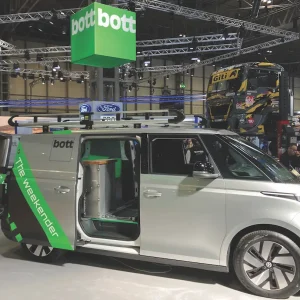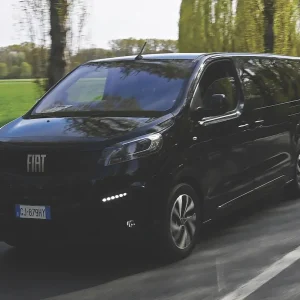Isuzu’s feat in winning the What Van? Pick-up of the Year Award with its D-Max for the second year running in 2019 is testament to the truck’s all-round capabilities and the breadth of the product range.
Isuzu’s commitment to a comprehensive list of bodystyles, with single cabs and extended cabs rather than just the more leisure-focused double cabs that proliferate elsewhere, is a crucial factor.
As an example, Isuzu UK’s managing director William Brown tells What Van? the utility company Scottish Southern Electric has recently chosen Isuzu to supply it with 215 D-Max models, in single-, extended- and double-cab bodystyles. The brand won the contract from Toyota, according to Brown, which, with its Hilux, is one of the few other manufacturers to market a full range of bodystyles.
Although it is demand for double-cabs that has fuelled the growth in the UK pick-up sector, there is little doubt this has been helped along by a taxation system that allows customers to reclaim VAT on the vehicles. If this concession were to be withdrawn, as many in the industry believe could be on the cards, it would be the brands offering only the so-called ‘lifestyle’ double-cabs that would be hit hardest.
While Isuzu produces its fair share of high-end double-cabs, such as the Utah, the D-Max’s roots are as a working vehicle.
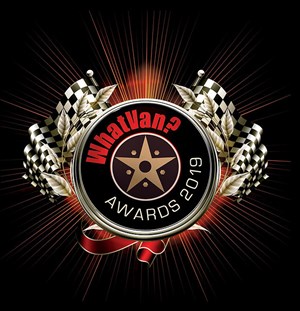
“We don’t claim to be the most car-like,” explains Brown, “just the best pick-up.”
Brown also highlights a proposed deal with the RAC for the supply of a patrol D-Max in extended-cab mode with enhanced towing ability of up to 2.8t even when the load bed’s payload is maxed out with heavy items, such as the car batteries RAC rescue vehicles carry.
This capacity, according to Brown, covers 90% of passenger vehicles. Isuzu has achieved the uprating, which Brown says has been type-approved, through the use of air suspension and has taken a trial order from the RAC for 50 trucks.
Brown describes retaining the What Van? award as “massive”, and adds: “It’s the biggest and best thing that could have happened to us.”
He says it’s an endorsement of the product and a “cornerstone” of Isuzu UK’s marketing campaigns.
While claiming the prize once could have been viewed as a flash in the pan, he adds: “If you win it twice, there’s credibility.”
Since the launch of the latest-generation D-Max in 2017, the importer has kept interest in the model alive with a series of tweaks and special editions, such as the Utah V-Cross that broke cover in January, and a couple of hardcore off-road collaborations with Arctic Trucks. And there were more on parade at the CV Show (see ‘Showtime’, below).
A new, or more likely, revised model will be coming, although Brown claims the Japanese HQ is not letting slip yet when this might be. “Not this year or soon,” he says, though.
He admits, however, that testing of a truck in Scandinavia has been spotted and says he’ll get official notification of when the next version is scheduled at the end of this year. Whatever date is set for the UK arrival, he tells us, it will be six months later than Thailand gets it.
One thing Brown is certain about, however, is that the next incarnation of the D-Max will keep the same 164hp 1.9-litre diesel engine that replaced the previous 2.5-litre unit in 2017.
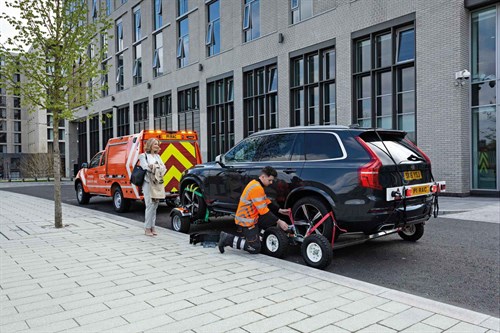
A deal between Isuzu and the RAC has been proposed
(Continued from page 1) At the time of its introduction questions were asked about whether the smaller engine could handle the sort of heavy-duty assignments for which the D-Max is renowned. Brown admits there were doubters, but claims Isuzu was ahead of the curve in that competitors are now downsizing their engines too.
At launch the manufacturer claimed development simulations showed 1.9 litres to be the optimum size to blend efficiency and also the torque necessary for the D-Max to retain its core capabilities. All demonstrators were fitted with tow bars to allow dealers to show off the truck’s workhorse credentials.
More appealing to punters resistant to change was the fact that the 1.9 D-Max was the only pick-up on the market not requiring the addition of AdBlue to meet the Euro6 emissions regulation.
“It will see through all the latest legislation,” Brown says of the drivetrain, before adding: “The customers who have bought it love it – it tows better, it’s more efficient, and quieter and more refined.”
But he acknowledges traditional customers, such as farmers, can be set in their ways and says there are those “who won’t even venture into a showroom to try it”.
Nevertheless, he is confident the tide is turning in favour of the downsized engine: “We’ve sold nearly 9,000 1.9s since 2017. Slowly but surely the negative comments are going away.”
Isuzu sold 4,888 D-Max models last year, according to the Society of Motor Manufacturer and Traders (SMMT), which made it the UK’s fifth biggest-selling pick-up, but the total was more than 2,000 units short of the fourth bestseller, the Toyota Hilux, which came in behind the Ford Ranger, Mitsubishi L200 and Nissan Navara. The top four all do more business with large fleets and this is an area of the market where Brown feels Isuzu can expand as well as continuing to focus on its more traditional bases of small and medium-sized businesses.
“You see national brands driving Isuzus now,” he says.
He does not expect the D-Max to overtake the Hilux in the near future but reveals Isuzu has set a target of reaching 10,000 sales by 2025. This figure has not been “plucked out of the air” but is based on putting various initiatives into action to grow large fleet volume. The aim is for 7,000 sales to go to retail customers and 3,000 to fleet. At present, Brown says, the split is 80/20%.
The importer has invested £1m in a new facility at the port of Sheerness, the point of entry for D-Max models to the UK, where livery and racking for fleet orders can be carried out as soon as the vehicles come off the boat.
Brown describes Isuzu as the odd one out in a pick-up sector that is dominated by flagship trim levels, such as Ford’s Ranger Wildtrak and Nissan’s Navara Tekna. D-Max sales are spread fairly evenly over the five specifications, with the mid-range Yukon, which sits below the Blade and Utah, the most popular.
In terms of price and in trading mainly to SMEs, the Korean brand Ssangyong, which is working to establish its Musso in the market, could be viewed as a competitor to Isuzu – the double-cab Musso Rebel and D-Max Yukon are both priced at around the £22,000 mark, for example – but Brown denies this is the case, pointing out the Musso is based on an SUV (the Ssangyong Rexton), so is “compromised” as a workhorse pick-up.
Instead he names the Hilux as being “within our sights”, while admitting Ford, Nissan and Mitsubishi are “miles above us” in volume terms.
Brown says Fiat’s withdrawal of its Fullback shows how competitive the market is and how difficult it is to break into for those not well established or adorned with a premium badge, such as the Mercedes X-Class.
Isuzu has 103 retail outlets in the UK and is aiming for 110, although there will be some churn before it reaches this number, says Brown.
“In January we told the dealers they need to pick up the pace,” he says.
He explains the brand does not take a very specific “pin in the map” approach to choosing locations but instead looks at general areas. Most retailers are owner/driver businesses selling cars, commercial vehicles or agricultural equipment, or they could even be used car dealers who don’t want to take on “loads of cost” or have “a manufacturer hitting [them] with a big stick. “We will increase the level of interest in the franchise, but the focus remains on the people not the facilities,” he concludes.
SHOWTIME
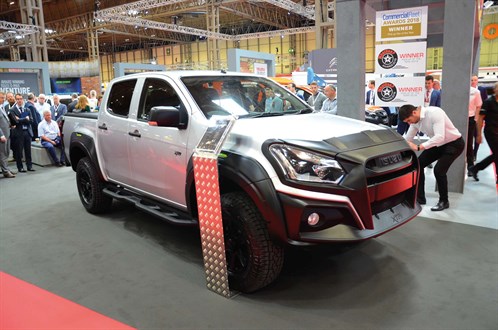
Isuzu unveiled a prototype version of the new D-Max XTR at the CV Show, which is available to pre-order now with prices starting at £33,999, excluding VAT. Set to sit between the flagship Blade and Arctic Trucks lines in the range, features include a specially engineered Pedders suspension and brake system, a body kit, side steps, 17in alloy wheels and 32in tyres. Also revealed was the AT35 Sakir, the latest in the line of extreme Arctic Trucks vehicles, which is set to be limited to just 10 examples.

